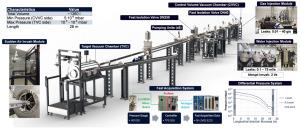MuVacAS: Experimental setup for testing mitigation strategies against Loss of Vacuum Accidents in the IFMIF-DONES accelerator
IF 2
3区 工程技术
Q1 NUCLEAR SCIENCE & TECHNOLOGY
引用次数: 0
Abstract
The IFMIF-DONES facility will irradiate prospective fusion reactor materials using a linear accelerator to collide a deuteron beam with a lithium target in a liquid state. A particularity of the IFMIF-DONES accelerator is the lack of physical separation between the target vacuum chamber (TVC), where liquid Li circulates, and the vacuum chambers of the upstream accelerator components. Loss of Vacuum Accidents (LOVAs) could thus result in the potential transport of material between the TVC and the rest of the accelerator, with the risk of potential reactions with the liquid Li or the mobilisation of radioactive inventory. This paper describes the Multipurpose Vacuum Accident Scenarios (MuVacAS) experimental setup, specifically designed to validate mitigation strategies against of such accidents. MuVacAS replicates the key characteristics of the last 49 m of the IFMIF-DONES accelerator vacuum chambers. It is equipped with modules to reproduce different leak scenarios, including sudden air inrushes or the controlled injection of various gases and water. Initial experimental results from a sudden air inrush scenario are presented, showcasing the capability of MuVacAS to accurately reproduce accident conditions in vacuum systems. Furthermore, the measurement systems were reliable during the tests, ensuring the data were valid and accurate. The planned experimental campaigns aimed at reproducing a variety of LOVAs are also outlined. The data collected in these campaigns will be used to assess the effectiveness of the Fast Safety Isolation Valves (FSIVs) — the primary mitigation devices for these accidents — and to support the design of the IFMIF-DONES safety systems.

MuVacAS:用于测试IFMIF-DONES加速器中真空损失事故缓解策略的实验装置
IFMIF-DONES设施将使用直线加速器照射未来聚变反应堆材料,使氘核束与液态锂靶发生碰撞。IFMIF-DONES加速器的一个特点是在Li液体循环的目标真空室(TVC)和上游加速器组件的真空室之间缺乏物理分离。因此,真空损失事故(LOVAs)可能导致物质在TVC和加速器其余部分之间的潜在运输,并有与液态锂发生潜在反应或动员放射性库存的风险。本文描述了多用途真空事故场景(MuVacAS)实验装置,专门设计用于验证针对此类事故的缓解策略。MuVacAS复制了IFMIF-DONES加速器真空室最后49米的关键特征。它配备了模块来重现不同的泄漏场景,包括突然的空气涌入或控制各种气体和水的注入。给出了突然空气涌入场景的初步实验结果,展示了MuVacAS在真空系统中精确再现事故条件的能力。此外,测量系统在测试过程中是可靠的,保证了数据的有效性和准确性。还概述了旨在复制各种lova的计划试验活动。在这些活动中收集的数据将用于评估快速安全隔离阀(FSIVs)的有效性——这是这些事故的主要缓解装置——并支持IFMIF-DONES安全系统的设计。
本文章由计算机程序翻译,如有差异,请以英文原文为准。
求助全文
约1分钟内获得全文
求助全文
来源期刊

Fusion Engineering and Design
工程技术-核科学技术
CiteScore
3.50
自引率
23.50%
发文量
275
审稿时长
3.8 months
期刊介绍:
The journal accepts papers about experiments (both plasma and technology), theory, models, methods, and designs in areas relating to technology, engineering, and applied science aspects of magnetic and inertial fusion energy. Specific areas of interest include: MFE and IFE design studies for experiments and reactors; fusion nuclear technologies and materials, including blankets and shields; analysis of reactor plasmas; plasma heating, fuelling, and vacuum systems; drivers, targets, and special technologies for IFE, controls and diagnostics; fuel cycle analysis and tritium reprocessing and handling; operations and remote maintenance of reactors; safety, decommissioning, and waste management; economic and environmental analysis of components and systems.
 求助内容:
求助内容: 应助结果提醒方式:
应助结果提醒方式:


